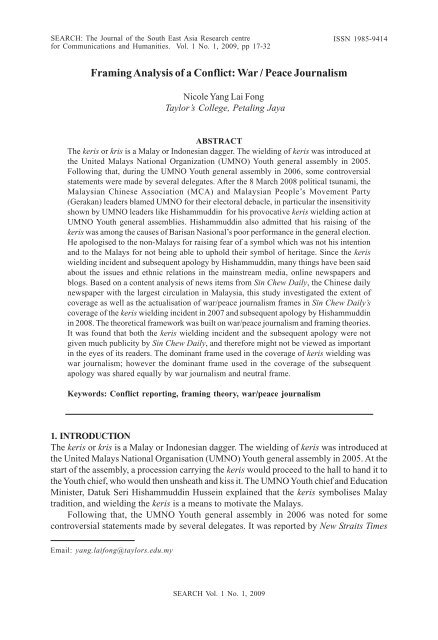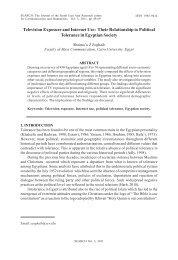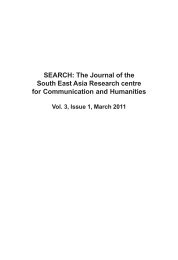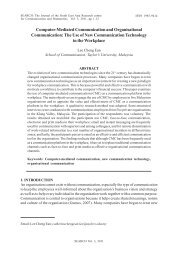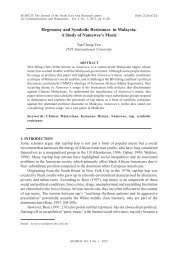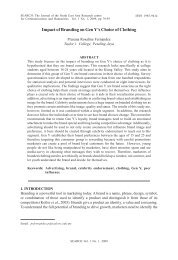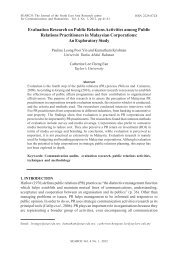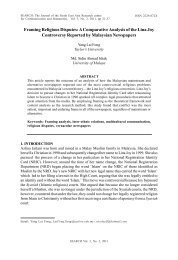Framing Analysis of a Conflict: War/Peace Journalism - Nicole Yang ...
Framing Analysis of a Conflict: War/Peace Journalism - Nicole Yang ...
Framing Analysis of a Conflict: War/Peace Journalism - Nicole Yang ...
- No tags were found...
Create successful ePaper yourself
Turn your PDF publications into a flip-book with our unique Google optimized e-Paper software.
SEARCH: The Journal <strong>of</strong> the South East <strong>Framing</strong> Asia Research <strong>Analysis</strong> centre <strong>of</strong> a <strong>Conflict</strong>: <strong>War</strong> / <strong>Peace</strong> <strong>Journalism</strong> ISSN 1985-9414 17for Communications and Humanities. Vol. 1 No. 1, 2009, pp 17-32<strong>Framing</strong> <strong>Analysis</strong> <strong>of</strong> a <strong>Conflict</strong>: <strong>War</strong> / <strong>Peace</strong> <strong>Journalism</strong><strong>Nicole</strong> <strong>Yang</strong> Lai FongTaylor’s College, Petaling JayaABSTRACTThe keris or kris is a Malay or Indonesian dagger. The wielding <strong>of</strong> keris was introduced atthe United Malays National Organization (UMNO) Youth general assembly in 2005.Following that, during the UMNO Youth general assembly in 2006, some controversialstatements were made by several delegates. After the 8 March 2008 political tsunami, theMalaysian Chinese Association (MCA) and Malaysian People’s Movement Party(Gerakan) leaders blamed UMNO for their electoral debacle, in particular the insensitivityshown by UMNO leaders like Hishammuddin for his provocative keris wielding action atUMNO Youth general assemblies. Hishammuddin also admitted that his raising <strong>of</strong> thekeris was among the causes <strong>of</strong> Barisan Nasional’s poor performance in the general election.He apologised to the non-Malays for raising fear <strong>of</strong> a symbol which was not his intentionand to the Malays for not being able to uphold their symbol <strong>of</strong> heritage. Since the keriswielding incident and subsequent apology by Hishammuddin, many things have been saidabout the issues and ethnic relations in the mainstream media, online newspapers andblogs. Based on a content analysis <strong>of</strong> news items from Sin Chew Daily, the Chinese dailynewspaper with the largest circulation in Malaysia, this study investigated the extent <strong>of</strong>coverage as well as the actualisation <strong>of</strong> war/peace journalism frames in Sin Chew Daily’scoverage <strong>of</strong> the keris wielding incident in 2007 and subsequent apology by Hishammuddinin 2008. The theoretical framework was built on war/peace journalism and framing theories.It was found that both the keris wielding incident and the subsequent apology were notgiven much publicity by Sin Chew Daily, and therefore might not be viewed as importantin the eyes <strong>of</strong> its readers. The dominant frame used in the coverage <strong>of</strong> keris wielding waswar journalism; however the dominant frame used in the coverage <strong>of</strong> the subsequentapology was shared equally by war journalism and neutral frame.Keywords: <strong>Conflict</strong> reporting, framing theory, war/peace journalism1. INTRODUCTIONThe keris or kris is a Malay or Indonesian dagger. The wielding <strong>of</strong> keris was introduced atthe United Malays National Organisation (UMNO) Youth general assembly in 2005. At thestart <strong>of</strong> the assembly, a procession carrying the keris would proceed to the hall to hand it tothe Youth chief, who would then unsheath and kiss it. The UMNO Youth chief and EducationMinister, Datuk Seri Hishammuddin Hussein explained that the keris symbolises Malaytradition, and wielding the keris is a means to motivate the Malays.Following that, the UMNO Youth general assembly in 2006 was noted for somecontroversial statements made by several delegates. It was reported by New Straits TimesEmail: yang.laifong@taylors.edu.mySEARCH Vol. 1 No. 1, 2009
18<strong>Nicole</strong> <strong>Yang</strong> Lai Fong(16 November 2006) that the Malacca delegate Hasnoor Sidang Hussein stated that “UMNOis willing to risk lives and bathe in blood in defence <strong>of</strong> race and religion”; UMNO YouthExco member Azimi Daim said that “when tension rises, the blood <strong>of</strong> Malay warriors will runin our veins”; and Perlis delegate Hashim Suboh directed his question at Hishammuddin:“Datuk Hisham has unsheathed his keris, waved his keris, kissed his keris. We want to askDatuk Hisham when he is going to use it.” There was uneasiness among the non-Malayswhen these speakers made racially slanted remarks about using the keris. In addition,things were made worse as the proceedings <strong>of</strong> the assembly were telecast live.The leaders <strong>of</strong> Malaysian Chinese Association (MCA) and Malaysian People’sMovement Party (GERAKAN) criticised the use <strong>of</strong> the keris in such a manner (The Star, 26April 2008). Despite that, Hishamuddin wielded the keris again at the UMNO Youth generalassembly in 2007. He later defended his action and explained that the act <strong>of</strong> wielding kerisonly aimed at injecting a new spirit among the younger Malays and he had no ulteriormotives.After the 8 March 2008 political tsunami, MCA and Gerakan leaders blamed UMNO fortheir electoral debacle, in particular the insensitivity shown by UMNO leaders likeHishammuddin for his provocative keris wielding action at UMNO Youth general assemblies.Hishammuddin also admitted that his raising <strong>of</strong> the keris was among the causes <strong>of</strong> theBarisan Nasional’s poor performance in the general election. He apologised to the non-Malays for raising the fear <strong>of</strong> a symbol which was not his intention and to the Malays fornot being able to uphold their symbol <strong>of</strong> heritage (The Star, 26 April 2008).Since the keris wielding incidents and subsequent apology by Hishammuddin, manythings have been said about the issues and ethnic relations in the mainstream media, onlinenewspapers and blogs. In addition, both the incidents have also unleashed a storm <strong>of</strong>protest from the Chinese community. Scholars highlighted that news media are disseminators<strong>of</strong> information and there is potential for conflict or even the existence <strong>of</strong> disagreement ordispute. The central integrative role <strong>of</strong> the media means that they play an active role incovering or not covering social conflicts (Domke, 2001; Mastin et al., 2005; Tichenor et al.,1980; Viswanath and Arora, 2000). Therefore, this study aimed to investigate the actualisation<strong>of</strong> war/peace journalism frames in Sin Chew Daily’s coverage <strong>of</strong> the keris wielding incidentin 2007 and subsequent apology by Hishammuddin in 2008. In this study, a news framerefers to an interpretive structure that sets specific events within a comprehensive context.The following research questions were raised for the study:RQ1: How extensively was the keris wielding incident and the subsequent apology coveredby Sin Chew Daily?RQ2: What was the dominant frame (war or peace journalism) used in the coverage <strong>of</strong> thekeris wielding incident and subsequent apology by Sin Chew Daily?2. THEORETICAL FRAMEWORKThis study relied on two theories to build its theoretical framework: (1) war/peace journalism,and (2) framing theory.SEARCH Vol. 1 No. 1, 2009
<strong>Framing</strong> <strong>Analysis</strong> <strong>of</strong> a <strong>Conflict</strong>: <strong>War</strong> / <strong>Peace</strong> <strong>Journalism</strong> 192.1 <strong>War</strong>/peace <strong>Journalism</strong>According to Seow and Maslog (2005), the news coverage <strong>of</strong> conflict, including the reportingabout war, is grounded in the notion <strong>of</strong> conflict as a news value. As a result, conflictreporting is <strong>of</strong>ten sensational and a mere device to boost circulation and ratings.Norwegian Pr<strong>of</strong>essor <strong>of</strong> <strong>Peace</strong> Studies, Johan Galtung first proposed peace journalismas a self-conscious, working concept for journalists covering wars and conflicts (Galtung,1998). He viewed peace journalism and war journalism as two competing frames in thecoverage <strong>of</strong> a conflict. He memorably likened war journalism to sports journalism, whichtypically sees its object in terms <strong>of</strong> a zero-sum game where winning is all. A better model, heargued, would be health journalism. Here the plight <strong>of</strong> a patient with cancer, for example,would be described but so too would the possible contributing causes–life style,environment, genetic make up–as well as the range <strong>of</strong> possible remedies and futurepreventative measures. This model would prove more productive in the context <strong>of</strong> conflictreporting than focusing on violence, negative events and siding with a particularprotagonist.<strong>War</strong> journalism is oriented in war/violence, propaganda, elites, and victory. In addition,war journalism plays up conflict as an arena where participants are grouped starkly into twoopposing sides (‘them vs. us’) in a zero-sum game and focuses on visible effects <strong>of</strong> war(casualties and damage to property).In contrast, peace journalism is a broader, fairer and more accurate way <strong>of</strong> framingstories, drawing on the insights <strong>of</strong> conflict analysis and transformation. Like public journalismand development journalism, peace journalism is grounded in communication philosophy–namely the commitment to the idea <strong>of</strong> civic participation, the understanding <strong>of</strong> social justiceas a moral imperative, and the view that the value and sacredness <strong>of</strong> the individual arerealised only in and through communities.By taking an advocacy, interpretative approach, the peace journalist concentrates onstories that highlight peace initiatives; tones down ethnic and religious differences, preventsfurther conflict, focuses on the structure <strong>of</strong> society; and promotes conflict resolution,reconstruction, and reconciliation by giving voice to all parties (not only two opposingsides), and creates empathy and understanding.Other peace journalism approaches include taking a preventive advocacy stance–forexample, editorials and columns urging reconciliation and focusing on common groundrather than on vengeance, retaliation, and differences–and emphasising the invisible effects<strong>of</strong> violence (e.g. emotional trauma and damage to social structure). Through careful,consistent, and conscientious application <strong>of</strong> peace journalism practices, the peace journalisthopes to create a setting in which the causes <strong>of</strong> and possible solutions to the conflictbecome transparent.2.2 <strong>Framing</strong> TheorySeow and Maslog (2005) found that war/peace journalism is supported by framing theorytheoretically. The origins <strong>of</strong> the framing concept lie in the fields <strong>of</strong> cognitive psychologyand anthropology. Subsequently, it was adopted by other disciplines, <strong>of</strong>ten with a shift inmeaning, including sociology, economics, linguistics, social-movements research, policySEARCH Vol. 1 No. 1, 2009
20<strong>Nicole</strong> <strong>Yang</strong> Lai Fongresearch, communication science, political communication, public relation research, andhealth communication.Tankard et al. (1991) defined media frame as the central organising idea for newscontent that supplies a context and suggests what the issue is through the use <strong>of</strong> selection,emphasis, exclusion, and elaboration. Similarly, Price et al. (1997) highlighted that an issueframe is a theme, story line, or label suggesting a preferred interpretation <strong>of</strong> some questions.Therefore, by focusing on selected aspects <strong>of</strong> an issue, Price et al. (1997) found that framescan switch particular trains <strong>of</strong> thought to the forefront <strong>of</strong> audience members’ consciousness,thereby affecting their cognition towards certain issues. McCombs (2005) further explainedthat to frame is to select some aspects <strong>of</strong> a perceived reality and make them more salient ina communicating text. In this manner, McCombs (2005) also found that media frame canpromote a particular problem definition, causal interpretation, moral evaluation, and/ortreatment recommendation for the item described.From the research methodology perspective, Weaver (2007) stated that frame can bestudied by means <strong>of</strong> systematic content analysis or more interpretive textual analysis alone.He also mentioned that framing is more concerned with how issues or other objects (people,groups, organisations, countries, etc.) are depicted in the media than with which issues orobjects are more or less prominently reported. It focuses on the most salient or prominentaspects or themes or descriptions <strong>of</strong> the objects <strong>of</strong> interest. In addition, Weaver (2007)emphasised that framing includes a broader range <strong>of</strong> cognitive processes such as moralevaluations, causal reasoning, appeals to principles, and recommendation for treatment <strong>of</strong>problems. Therefore, he claimed that framing is about efforts at making sense <strong>of</strong> an issue.In recent years, framing theory has taken over from agenda-setting as the mostcommonly applied research approach in the field <strong>of</strong> communication science (Bryant andMiron, 2004). Domke (2001) found that there is a small but growing body <strong>of</strong> survey andexperimental research suggesting that public opinion on race depends on a systematic andintelligible way on how the issues are framed by interest groups, elites and news media. Inan experimental study conducted by Domke (2001), he too found that racial cues in newscoverage not only trigger the association between racial perceptions and political ideologybut in turn may prompt individuals to become more ideologically distinct in their politicalevaluations. Richardson (2005) also conducted an experiment to investigate the impact <strong>of</strong>editorial framing on readers’ political cognition and effect toward a different racial group. Itwas found that frames can activate distinct social identities within the minds <strong>of</strong> readers,priming their applicability to the task at hand.Figure 1 represents the research framework <strong>of</strong> this study, which was establishedaccording to the theories mentioned above. It illustrates the overall relationships betweenthe independent and dependent variables. The independent variables were (1) the extent <strong>of</strong>coverage, and (2) dominant frame found in the news items. The dependent variable was thecoverage <strong>of</strong> the keris wielding incident and subsequent apology by Sin Chew Daily.3. METHODThis study was based on a content analysis <strong>of</strong> news items from Sin Chew Daily, theChinese daily newspaper with the largest circulation in Malaysia. The unit <strong>of</strong> analysis wasthe news items from editorials, straight news and letters from readers. The sample <strong>of</strong> thisSEARCH Vol. 1 No. 1, 2009
<strong>Framing</strong> <strong>Analysis</strong> <strong>of</strong> a <strong>Conflict</strong>: <strong>War</strong> / <strong>Peace</strong> <strong>Journalism</strong> 21Independent VariablesExtent <strong>of</strong> Coverage– Number <strong>of</strong> news items– Types <strong>of</strong> news items– Location <strong>of</strong> news items– Published day <strong>of</strong> news items– Size <strong>of</strong> news items bySin Chew DailyDominant Frame– <strong>War</strong> <strong>Journalism</strong>– <strong>Peace</strong> <strong>Journalism</strong>Dependent VariableCoverage <strong>of</strong> Keris wieldingand subsequent apologyFigure 1. Research framework <strong>of</strong> studystudy was drawn from the main section <strong>of</strong> the newspaper; it excluded the additional sectionslike sports, international, features and others.This study investigated the coverage <strong>of</strong> Sin Chew Daily on the keris wielding incidentin 2007 and subsequent apology by Hishammuddin in 2008. The sample for keris wieldingwas drawn from 1- 30 November 2007, while the sample for apology was drawn from 26 Aprilto 30 May 2008. These dates were chosen respectively because the period carried the mostcoverage on the issues. There were 20 and 14 news items found to be related to the keriswielding incident and apology respectively. This study used the census sample <strong>of</strong> the newsitems and each <strong>of</strong> them was given an identification number starting from number 1 to 34.The extent <strong>of</strong> coverage was studied from five angles: (1) number <strong>of</strong> news items, (2)types <strong>of</strong> news items, (3) location <strong>of</strong> news items, (4) size <strong>of</strong> news items, and (5) published day<strong>of</strong> news items. The coding categories for frames, based on Galtung’s (1998) classification,involved 13 indicators <strong>of</strong> war journalism and 13 indicators <strong>of</strong> peace journalism (refer toAppendix). After a preliminary examination <strong>of</strong> the data, this study modified Galtung’scoding categories into 5 indicators <strong>of</strong> war journalism and 5 indicators <strong>of</strong> peace journalism asshown in Table 1.4. FINDINGSAs mentioned earlier, <strong>of</strong> the 34 news items analysed, 20 were related to the keris wieldingincident and 14 were related to apology.4.1 Extent <strong>of</strong> CoverageThe extent <strong>of</strong> coverage by Sin Chew Daily was studied from five angles: (1) number <strong>of</strong> newsitems, (2) types <strong>of</strong> news items, (3) location <strong>of</strong> news items, (4) size <strong>of</strong> news items, and (5)published day <strong>of</strong> news items.SEARCH Vol. 1 No. 1, 2009
22<strong>Nicole</strong> <strong>Yang</strong> Lai FongTable 1. Coding categories for frames<strong>War</strong> <strong>Journalism</strong><strong>Peace</strong> <strong>Journalism</strong>1. Elite-oriented 1. People-orientedFocuses on leaders and elites asFocuses on common people as actors andactors and sources <strong>of</strong> information. sources <strong>of</strong> information.2. Differences-oriented 2. Reports the areas <strong>of</strong> agreementReports on areas <strong>of</strong> differences that might Reports on areas that might lead to a solution tolead to a worsening <strong>of</strong> conflict .the conflict.3. Focuses on here and now 3. Reports causes and consequencesNeither reports on factors contributing Reports on factors contributing toto conflicts nor consequences <strong>of</strong> it.conflicts as well as consequences <strong>of</strong> it.Only reports aboutwhat, who, where andwhen <strong>of</strong> an event.4. Dichotomises the good and bad 4. Avoids labeling <strong>of</strong> good guys and bad guysPoints finger at other quarters as responsible Does not point fingers at other quarters asfor issue.responsible <strong>of</strong> the issue.5. Partisan 5. Non- partisanBiased to one side <strong>of</strong> conflict.Neutral and not taking sides.As shown in Table 2, the majority <strong>of</strong> the news items analysed were straight newsarticles. The coverage <strong>of</strong> the keris wielding incident carried 90% straight news articles,while the coverage <strong>of</strong> apology consisted <strong>of</strong> 92.9% straight news articles. The majority <strong>of</strong> thenews items were located at the non-front pages.The majority <strong>of</strong> the news items were small in size, which was 200cm 2 or less. On average,keris wielding had 165cm 2 and apology had 356.4cm 2 <strong>of</strong> article size. A finding <strong>of</strong> interest wasthat 90% <strong>of</strong> the coverage <strong>of</strong> the keris wielding incident fell on weekdays, while 78.6% <strong>of</strong> thecoverage <strong>of</strong> apology fell on weekends.4.2 Dominant Frame <strong>of</strong> CoverageOf the 20 news items found for the coverage <strong>of</strong> keris wielding, 95% was framed as warjournalism compared to 5% neutral (Table 3). On the other hand, the 14 news items forapology were shared equally by war journalism (50%) and neutral frame (50%).4.3 Indicators <strong>of</strong> <strong>War</strong> <strong>Journalism</strong> for the Coverage <strong>of</strong> Keris Wielding ActAs shown in Table 4, the indicators supporting war journalism frame for the coverage <strong>of</strong> thekeris wielding act, based on a total frequency count <strong>of</strong> 52, were elite orientation (100%),partisanship (80%), dichotomy <strong>of</strong> the good and bad (45%), here-and-now focus (20%), anddifferences orientation (15%).By being elite-oriented, Sin Chew Daily focused on leaders and elites as actors andsources <strong>of</strong> information for the coverage <strong>of</strong> the keris wielding incident. These elites includedthose from the United Malays National Organisation(UMNO) (60%); Malaysian ChineseSEARCH Vol. 1 No. 1, 2009
<strong>Framing</strong> <strong>Analysis</strong> <strong>of</strong> a <strong>Conflict</strong>: <strong>War</strong> / <strong>Peace</strong> <strong>Journalism</strong> 23Table 2. Extent <strong>of</strong> coverageKeris wielding (n=20)%Apology (n=14)%Type:Straight news 90.0 92.9Editorial 10.0 7.1Letter from readers 0 0Location:Front page 5.0 7.1Inner back page 5.0 0Other 90.0 92.9Size (cm 2 ):0 – 100.0 40.0 35.7100.1 – 200.0 45.0 28.6200.1 – 300.0 5.0 7.1300.1 – 400.0 0 14.3400.1 – 500.0 5.0 0500.1 and above 5.0 14.3Mean 165.0 356.4Day:Weekdays 90 21.4Weekend 10 78.6Table 3. Dominant frames <strong>of</strong> coverageFrame Keris wielding (n=20)% Apology (n=14)%<strong>War</strong> journalism 95.0 50.0<strong>Peace</strong> journalism 0 0Neutral 5.0 50.0Association(MCA) (10%), Malaysian People’s Movement Party (Gerakan) (5%), People’sProgressive Party (PPP) (5%), Democratic Action Party (DAP) (5%), People’s Justice Party(PKR) (5%), and Sin Chew Daily’s editorial board (5%). In addition, it was found that 85%<strong>of</strong> the source <strong>of</strong> information came from BN and only 10% from opposition parties.Partisanship happened when the coverage was found to be biased in the keris wieldingconflict. Among the news items that demonstrated partisanship, 75% <strong>of</strong> them conveyed afavourable impression towards the keris; keris wielding act; or Hishammuddin and thegovernment. The news items either supported or justified the keris wielding act. Asmentioned earlier, there was an article on the front page that carried three photographs,which showed respectively <strong>of</strong> Hishammuddin accepting, unsheathing and kissing the keris.Nevertheless, next to these potentially unfavourable photographs was a favourable headline“Hishammuddin told UMNO Youth delegates that it is not a zero-sum game, (the government)SEARCH Vol. 1 No. 1, 2009
24<strong>Nicole</strong> <strong>Yang</strong> Lai FongTable 4. Indicators <strong>of</strong> war and peace journalism in coverage <strong>of</strong> Keris wielding actFrame Frequency Percentage (%)(n = 20)<strong>War</strong> journalismElite-oriented 20 100.0Differences-oriented 3 15.0Focuses on here and now 4 20.0Dichotomises good and bad 9 45.0Partisan 16 80.0Total 52<strong>Peace</strong> journalismPeople-oriented 0 0Reports areas <strong>of</strong> agreement 12 60.0Reports causes and consequences 4 20.0Avoids labeling <strong>of</strong> good guys and bad guys 11 55.0Non-partisan 4 20.0Total 31does not restrict the development <strong>of</strong> Chinese and Tamil primary schools.” Although thephotographs were not seem to be related to the article, the favorable headline might be ableto focus the readers’ attention on the positive attribute <strong>of</strong> Hishammuddin rather than thepossible antagonistic meaning portrayed by the photographs.On the other hand, among the articles that exhibited partisanship, 25% conveyed anegative meaning that might cause the readers to form a negative opinion about the keris;keris wielding act; Hishammuddin or the government. There was an article reporting thespeech <strong>of</strong> the Deputy Chief <strong>of</strong> the UMNO Youth wing, Khairy Jamaluddin, who insistedthat the keris will be unsheathed and wielded as long as UMNO Youth exists. He alsomentioned that anyone who dares not to wield the keris in the future will be viewed as atraitor to the Malay community and UMNO.In pursuing dichotomy <strong>of</strong> the good and bad, the articles assigned blame to one party,or to the one who started the conflict. Among the 45% <strong>of</strong> articles containing this indicator,15% blamed Hishammuddin for wielding the keris, 15% blamed the UMNO delegates formaking extreme and <strong>of</strong>fensive remarks during the UMNO Youth general assembly in 2006,and 15% blamed the opposition parties or foreign media for blowing up the keris wieldingissue.Through a here-and-now perspective, the coverage only reported about the what,who, where and when <strong>of</strong> an event rather than the factors contributing to the conflicts or theconsequences <strong>of</strong> it. For example, some <strong>of</strong> the coverage only reported the ceremony <strong>of</strong> thekeris wielding and the agenda for UMNO general assembly in 2007.By adopting the differences orientation, the coverage reported on areas <strong>of</strong> differencesthat might lead to a worsening <strong>of</strong> the conflict. These included quotes by individuals whorefuted the explanation for keris wielding; criticism on the act <strong>of</strong> keris wielding as insensitive,hostile and doing severe damage to national unity and nation building.SEARCH Vol. 1 No. 1, 2009
<strong>Framing</strong> <strong>Analysis</strong> <strong>of</strong> a <strong>Conflict</strong>: <strong>War</strong> / <strong>Peace</strong> <strong>Journalism</strong> 254.4 Indicators <strong>of</strong> <strong>Peace</strong> <strong>Journalism</strong> for the Coverage <strong>of</strong> Keris Wielding ActAs shown in Table 3, the indicators supporting peace journalism frame for the coverage <strong>of</strong>the keris wielding act, based on a total frequency count <strong>of</strong> 31, were agreement orientation(60%), avoidance <strong>of</strong> labelling <strong>of</strong> good and bad (55%), causes-and-consequences approach(20%), and non-partisanship (20%).In pursuing an agreement orientation, the articles reported on areas that might lead toa solution for the keris wielding issue. The coverage included voices giving credit toHishammuddin for his contribution as an Education Minister to the non-Malays. Therewere also articles that reported the explanation for keris wielding given by Hishamuddinand other UMNO leaders. Besides, there were quotes by BN leaders that urged the non-Malays not to worry about the act <strong>of</strong> keris wielding; not to be influenced by the racialsentiment; to disseminate Hishammuddin’s explanation to others; and to quit the debateand put it to rest. Some articles also reported assurances from the government that all ethnicgroups will be protected.Through avoidance <strong>of</strong> labelling <strong>of</strong> good and bad, the articles did not assign blame toanyone. By adopting causes-and-consequences approach, the news items reported factorscontributing to the keris wielding conflict. It was reported that the issue was not with thekeris but the context in which it was wielded. The non-Malays perceived the action <strong>of</strong>Hishammudin wielding the keris for three consecutive years as defending ketuanan Melayu(Malay supremacy) and to threaten those who oppose Malay special rights. The non-Malays also felt that wielding a keris at a highly charged political meeting was confrontational,combative and trampled on the rights and sensitivities <strong>of</strong> the non-Malays.The articles were neutral by being non-partisan. This means that the news items neitherportrayed the keris or keris wielding act favourably nor unfavourably; neither supportednor condemned Hishammuddin and the government.4.5 Indicators <strong>of</strong> <strong>War</strong> <strong>Journalism</strong> for Coverage <strong>of</strong> ApologyAs represented in Table 5 the indicators supporting war journalism frame for the coverage <strong>of</strong>apology, based on a total frequency count <strong>of</strong> 34, were elite orientation (100%), partisanship(78.6%), dichotomy <strong>of</strong> the good and bad (45.5%), and differences orientation (28.6%).As in the case <strong>of</strong> coverage <strong>of</strong> the keris wielding act, Sin Chew Daily also relied 100%on the elites as the source <strong>of</strong> information while ignoring the common citizen in its coverage<strong>of</strong> apology. These elites included those from the United Malays National Organisation(UMNO) (42.9%); Malaysian People’s Movement Party (Gerakan) (14.3%); MalaysianChinese Association (MCA) (7.1%); Malaysian Indian Congress (MIC) (7.1%), DemocraticAction Party (DAP) (14.3%); and Sin Chew Daily’s editorial board (7.1%).Among the articles that exhibited partisanship, 72.7% conveyed a favourable impressionon the apology, while only 27.3% conveyed a negative meaning toward the issue. Througha dichotomy <strong>of</strong> bad and good perspectives, the articles reported that it was not merelyHishammuddin’s fault in the keris wielding conflict, rather, other quarters like a few UMNOdelegates who made racist remarks, the Opposition parties and foreign media were those tobe blamed for making the issue sensitive. There was an article which quoted the speech <strong>of</strong>an UMNO representative, who criticised the Chinese and Indians for being demanding.SEARCH Vol. 1 No. 1, 2009
26<strong>Nicole</strong> <strong>Yang</strong> Lai FongTable 5. Indicators <strong>of</strong> war journalism and peace journalism in coverage <strong>of</strong> apologyFrame Frequency Percentage (%)(n = 14)<strong>War</strong> journalism:Elite-oriented 14 100.0Differences-oriented 4 28.6Focuses on here and now 0 0Dichotomises the good and bad 5 45.5Partisan 11 78.6Total 34<strong>Peace</strong> journalism:People-oriented 0 0Reports the areas <strong>of</strong> agreement 8 57.1Reports causes and consequences 6 42.9Avoids labelling <strong>of</strong> good guys and bad guys 14 31.0Nonpartisan 3 21.4Total 31And therefore the UMNO representative felt that Hishammuddin should not apologisebecause it would denigrate the party in addition to its failure in the 12 th General Election (SinChew Daily, 28 April 2008).A difference orientation was demonstrated when the news items reported on areas <strong>of</strong>differences that might lead to a worsening <strong>of</strong> the problem. There were news items thatclaimed Hishammuddin’s apology to be late and insincere. There was coverage on complaintsthat UMNO plays race politics, and the keris wielding incident has hurt the feelings <strong>of</strong> theChinese badly as they had already encountered much unfair treatment and policies. Therewas also coverage on demand to all politicians who had given racist speeches to apologise.4.6 <strong>Peace</strong> <strong>Journalism</strong> Frame for the Coverage <strong>of</strong> ApologyThe indicators supporting peace journalism frame for the coverage <strong>of</strong> apology, based on atotal frequency count <strong>of</strong> 31, were agreement orientation (57.1%), causes-and-consequencesapproach (42.9%), avoidance <strong>of</strong> labelling <strong>of</strong> good and bad (31%), and non-partisanship (21.4%).By adopting agreement orientation, the coverage <strong>of</strong> apology reported on areas thatmight lead to a solution. The articles included voices giving credit to Hishammuddin for hiscontribution as an Education Minister to the non-Malays. Some articles gave voice tothose who explained the meaning <strong>of</strong> keris wielding and praised Hishammuddin forapologising. Hishammuddin was praised to be courageous, sincere and noble. Some articlesincluded quotes by UMNO leaders, who said that Hishammuddin did not denigrate theMalays by apologising, while others reported that the apology was not late. The non-Malays were also urged by BN leaders to accept Hishammuddin’s apology in good faith,and to quit the debate. There was an article that reported the press statement given by thepresident <strong>of</strong> the Federation <strong>of</strong> Chinese Associations Malaysia, Lim Gait Tong. He praisedHishamuddin for apologising and demonstrating a good example <strong>of</strong> a great leader. He alsoSEARCH Vol. 1 No. 1, 2009
<strong>Framing</strong> <strong>Analysis</strong> <strong>of</strong> a <strong>Conflict</strong>: <strong>War</strong> / <strong>Peace</strong> <strong>Journalism</strong> 27advised all politicians not to speak for only one ethnic group, and to take heed <strong>of</strong> everygroup’s feeling. Moreover, Lim urged Hishammuddin to accept the Chinese community’sopinion when making decisions about Chinese education. He hoped that Hishammuddinwould revert to the policy <strong>of</strong> using mother tongue as the medium for teaching mathematicsand science in the national-type primary schools.Through the causes-and-consequences approach, the articles again reported that theissue was not with the keris but the context in which it was wielded. By avoidance <strong>of</strong>labelling <strong>of</strong> good and bad, the articles did not assign blame to anyone. And lastly, by beingnon-partisan, the articles neither portrayed the apology or keris wielding favourably norunfavourably.5. DISCUSSIONReaders <strong>of</strong> newspapers learn about issues <strong>of</strong> significance to their communities, and howmuch importance to attach to the issues, based on the amount <strong>of</strong> coverage given to them.Newspapers play a central role in shaping political and social reality because the editorsand publishers are usually members <strong>of</strong> the elite (Weill and Castaneda, 2004). With only 20and 14 small-sized articles found to be related to keris wielding and subsequent apologyrespectively, it is tempting to say that both the issues were not given much publicity by SinChew Daily, and therefore might not be viewed as important in the eyes <strong>of</strong> its readers.However, Sin Chew Daily enjoys better readership on weekends compared to weekdays(Selva, 2007), therefore the coverage on apology, which was published mostly on weekendsmight have reached and publicised to more readers than on weekdays.McCombs (2005) noted that readers depend very heavily on the type <strong>of</strong> materials madeavailable through the newspapers; the relative prominence given to different types <strong>of</strong>material and the way it is handled in order to evaluate an issue. Straight news articles givefacts or quote references on general information like who, what, when, where, why and how.Palvik and McIntosh (2004) called this the surveillance function <strong>of</strong> journalism. On the otherhand, editorials are opinion pieces that <strong>of</strong>ten identify, define, articulate and address currentevents or public controversies. Written by members <strong>of</strong> the editorial board, editorials reflectthe stance <strong>of</strong> the newspaper. Palvik and McIntosh (2004) called the function <strong>of</strong> this type <strong>of</strong>journalism as correlation. By devoting most <strong>of</strong> the coverage <strong>of</strong> keris wielding and apologyto straight news articles and very little space for editorials, Sin Chew Daily was mostlyperforming surveillance instead <strong>of</strong> a correlation function. It also hardly exposed the readersto opinions and comments, considered essential for evaluation <strong>of</strong> the issues.The finding that Sin Chew Daily relied heavily on the elite as the source <strong>of</strong> informationin the coverage <strong>of</strong> keris wielding act and subsequent apology was consistent with Nero’s(2002) remarks. Like other countries in Southeast Asia, Nero (2002) found that Malaysiansociety values authority and power, which are mainly possessed by those occupying ahigher position <strong>of</strong> authority in the community. The higher the rank <strong>of</strong> authority, the moreprestigious the person is in the eyes <strong>of</strong> others. Nero (2002) also noticed that newspapers inthe developing countries have the tendency to use sources that appear to be credible or tolend credibility to the messages contained in their reports. The higher seat a person occupiesin a hierarchy <strong>of</strong> authority, the higher his perceived credibility as a source <strong>of</strong> that news.SEARCH Vol. 1 No. 1, 2009
28<strong>Nicole</strong> <strong>Yang</strong> Lai FongTherefore, newspapers are inclined to obtain more information from authoritative sources,as they are the decision-makers in society and possess the necessary resources to implementthe decision regarding development projects.As Sin Chew Daily relied heavily on UMNO leaders as the source <strong>of</strong> information andgiving very little voice to the opposition parties, it allowed the dominant political party inthe country to act as the opinion leader and to define the keris wielding and apology issues.According to Shamsul (2005), there is a strong and yet unhealthy tendency in Malaysia toview oppositionism negatively, both by academics and non-academics. This has led to thegovernment and individuals being intolerant to criticism, including healthy ones. Indeed,some even see oppositionism as something negative and bad for national unity and nationalintegration. In addition, this study also found that the citizens were not invited by SinChew Daily to give their comment and debate on both the issues, and therefore the readerswere more the observers and less the active players.A closer examination <strong>of</strong> the pattern <strong>of</strong> war journalism in the coverage <strong>of</strong> keris wieldingreveals that the framing is highly favourable towards Hishammuddin. For example, therewas a strong tendency to quote individuals who supported or justified the keris wieldingact; and blaming others instead <strong>of</strong> Hishammuddin as responsible for the conflict. There aremany reasons why newspapers cannot always perform their roles as “critic” or “stimulantfor discussion <strong>of</strong> an issue”. According to Marder (2001), the reasons may be the domestictensions that limit the “extent <strong>of</strong> being frank” by the mass media, while political and financialpressures may also tend to discourage public discussion <strong>of</strong> certain topics. Lent (1990)identified Malaysia as the Southeast Asian nation that has been most active in reorientingmedia to function in a pluralistic society. In this regard, mass media are used to play downmaterials that touch upon communal sensitivities.In the coverage <strong>of</strong> apology, there was a shift to peace journalism and neutral frame bySin Chew Daily. The four indicators found supporting peace journalism frame (agreementorientation, causes-and-consequences focus, avoidance <strong>of</strong> labelling good and bad, andnon-partisanship) although important in the overall scheme <strong>of</strong> peace journalism, however,are merely reporting the facts as they are. These indicators did not represent an activeattempt played by the journalists to play a strong contributory, proactive role in <strong>of</strong>feringresolution or promoting integration. <strong>Peace</strong> journalism is a self-conscious concept, and theframing <strong>of</strong> the apology may be more reflective <strong>of</strong> a cautious attitude in reporting acontroversial issue.More disappointingly, none <strong>of</strong> the peace journalism stories were supported by a peopleorientation. Shamsul (2005) emphasised that the bottom-up collective expression <strong>of</strong> variousgroups at the grassroots can help to redefine and refine many aspects that sometimesescape the attention <strong>of</strong> the people in power. With little focus on ordinary people, andwithout finding out whether their position as stated by the elites is reflective <strong>of</strong> the truefeelings on the ground, there is little that journalists can do to empower the ordinary people.6. CONCLUSIONAs stated by Viswanath and Arora (2000), in the interest <strong>of</strong> system maintenance, the primaryfunction <strong>of</strong> media is social control. Media draw attention to what is acceptable and notSEARCH Vol. 1 No. 1, 2009
<strong>Framing</strong> <strong>Analysis</strong> <strong>of</strong> a <strong>Conflict</strong>: <strong>War</strong> / <strong>Peace</strong> <strong>Journalism</strong> 29acceptable within the dominant norms and values <strong>of</strong> the community. Media provide platformsin which potential social problems are identified, defined, and articulated.This study found that both the keris wielding incident and the subsequent apologywere not given much publicity by Sin Chew Daily, and therefore might not be viewed asimportant in the eyes <strong>of</strong> its readers. The dominant frame used in the coverage <strong>of</strong> keriswielding was war journalism; however, the dominant frame used in the coverage <strong>of</strong> thesubsequent apology was shared equally by war journalism and neutral frame.It is believed that the findings from this study will be helpful in understanding how SinChew Daily handled racial controversy. More research is needed, however, especially atthe level <strong>of</strong> news gatekeeping to investigate the factors contributing to the coverage <strong>of</strong> thekeris wielding act and subsequent apology by Sin Chew Daily. Also, more research isneeded to investigate the perception <strong>of</strong> Sin Chew Daily readers towards the issues todetermine the effect <strong>of</strong> the coverage on the readers.REFERENCESBRYANT, J. and MIRON, D. (2004). Theory and research in mass communication. Journal <strong>of</strong>Communication, 54(4): 662-704.DOMKE, D. (2001). Racial cues and political ideology: an examination <strong>of</strong> associative priming.Communication Research, 28(6): 772-801.GALTUNG, J. (1998). <strong>Peace</strong> journalism: What, why, who, how, when, where. Paper presented in,What are Journalists For? Workshop, 3-6 September 1998. TRANSCEND, Taplow Court,UK.LENT. J. A. (1990). The development <strong>of</strong> multicultural stability in ASEAN: the role <strong>of</strong> mass media.Journal <strong>of</strong> Asian Pacific Communication, 4(1): 45-58.MARDER, M. (2001). Press failure to watchdog can have devastating consequences. Nieman Reports,55(2): 65-66.MASTIN, T., CAMPO, S. and FRAZER, M. S. (2005). In Black and White: coverage <strong>of</strong> U. S. slavereparations by the mainstream and Black press. The Howard Journal <strong>of</strong> Communication, 16:201-223.McCOMBS, M. (2005). Setting the Agenda: the Mass Media and Public Opinion. Malden, MA:Blackwell.NERO, A. (2002). Media freedom in Malaysia: the challenge facing civil society. Media Asia, 29(1):22-35.PALVIK, J. V. and MCINTOSH, S. (2004). Converging Media: an Introduction to MassCommunication. Boston: Pearson Education, Inc.PRICE, V., TEWKSBURY, D and POWERS, E. (1997). Switching trains <strong>of</strong> thought: the impact <strong>of</strong>news frames on readers’ cognitive responses. Communication Research, 24: 281-506.SEARCH Vol. 1 No. 1, 2009
30<strong>Nicole</strong> <strong>Yang</strong> Lai FongRICHARDS, T. (2001). Media and conflict portrayal. <strong>Conflict</strong> Resolution Notes, 18(4): 122-131.SELVA, J. (2007). Malaysia Media Planning Guide 2007. Kuala Lumpur: Perception Media Sdn Bhd.SEOW, T. L. and MASLOG, C. C. (2005). <strong>War</strong> or peace journalism? Asian newspaper coverage <strong>of</strong>conflicts. Journal <strong>of</strong> Communication, 55(2): 311-329.SHAMSUL AMRI BAHARUDDIN (1999). Identity contestation in Malaysia: a comparativecommentary on ‘Malayness’ and ‘Chineseness’. Akademika, 55 (July).SIN CHEW DAILY. (2008). Hishammuddin does not need to apologise for wielding the keris, 28April 2008, p. N14.NEW STRAITS TIMES (2006). BN parties refuse to take the bait. New Straits Times, 16 November,Main Section.TANKARD, J., HENDRICKSON, L., SILBERMAN, J., BLISS, K. and GHANEM, S. (1991).Media frames: Approaches to conceptualization and measurement. Paper presented at theAnnual Convention <strong>of</strong> the Association for Education in <strong>Journalism</strong> and Mass Communication,Boston, MA.THE STAR (2008). Hisham regrets wielding keris, he apologises to all Malaysians. The Star, 26April, Nation.TICHENOR, P. J., DONOHUE, G. A. and OLIEN, C. N. (1980). Community <strong>Conflict</strong> and the Press.Beverly Hills, CA: Sage.VISWANATH, K. and ARORA, P. (2000). Ethnic media in the United States: an essay on their rolein integration, assimilation, and social control. Journal <strong>of</strong> Mass Communication & Society, 3(1),39-56.WEAVER, D. H. (2007). Thoughts on agenda setting, framing, and priming. Journal <strong>of</strong> Communication,57(1): 142-147.WEILL, S. AND CASTANEDA, L. (2004). ‘Empathetic rejectionism’ and inter-ethnic agenda setting:coverage <strong>of</strong> Latinos by the Black Press in the American South. <strong>Journalism</strong> Studies, 5(4): 537-550.SEARCH Vol. 1 No. 1, 2009
<strong>Framing</strong> <strong>Analysis</strong> <strong>of</strong> a <strong>Conflict</strong>: <strong>War</strong> / <strong>Peace</strong> <strong>Journalism</strong> 31AppendixGaltung’s (1998) coding categories for frames<strong>War</strong> <strong>Journalism</strong>Approach:<strong>Peace</strong> <strong>Journalism</strong>Approach:1. Reactive 1. Proactive– Waits for war to break out, or about to – Anticipates, starts reporting long beforebreak out, before reportingwar breaks out2. Visible effects <strong>of</strong> war 2. Reports also on invisible effects <strong>of</strong> war– Casualties, dead and wounded, – Emotional trauma, damage to society anddamage to propertyculture3. Elite-oriented 3. People-oriented– Focuses on leaders and elites as actors – Focuses on common people as actors andand sources <strong>of</strong> informationsources <strong>of</strong> information4. Differences-oriented 4. Reports areas <strong>of</strong> agreementthat might lead to a solution to conflict5. Focuses on here and now 5. Reports causes and consequences <strong>of</strong>the conflict6. Dichotomises good and bad, 6. Avoid labeling <strong>of</strong> good guys and bad guysvictims and villains7. Two-party orientation 7. Multiparty orientation– One party wins, one party loses – Gives voice to many parties involvedin conflict8. Partisan 8. Non-partisanBiased for one side in conflict– Neutral, not taking sides9. Zero-sum orientation 9. Win-win orientation– One goal: to win – Many goals and issues, solution-oriented10. Stops reporting and leaves after war 10. Stays on and reports aftermath <strong>of</strong> war– Stops reporting with peace treaty – reconstruction, rehabilitation, andsigning and ceasefire and heads for another implementation <strong>of</strong> peace treatywar elsewhereContinued on next pageSEARCH Vol. 1 No. 1, 2009
32<strong>Nicole</strong> <strong>Yang</strong> Lai FongAppendix continuedLanguage:Language:1. Uses victimising language that tells 1. Avoids victimising languageonly what has been done to people– Reports what has been done and could be– For example, destitute, devastated, done by people, and how they are copingdefenseless, pathetic, tragic, demoralised2. Uses demonising language 2. Avoids demonising language– For example, vicious, cruel, brutal, – Uses more precise descriptions, titles,barbaric, inhuman, tyrant, savage, ruthless, or namesterrorist, extremist, fanatic, fundamentalist3. Uses emotive language 3. Avoids emotive words– For example, genocide, assassination, – Objective and moderate. Reserves strongestmassacre, systematic (as in systematic language only for gravest situation. Doesraping or forcing people from their homes not exaggerateSEARCH Vol. 1 No. 1, 2009


